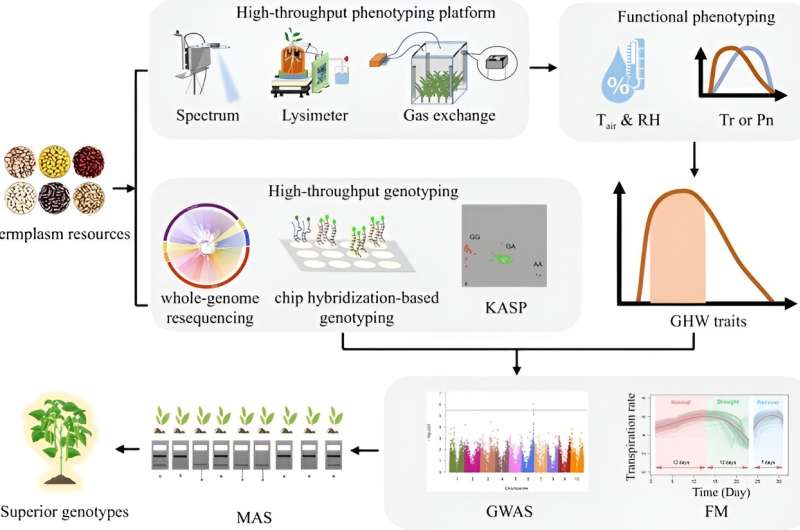This article has been reviewed according to Science X's editorial process and policies. Editors have highlighted the following attributes while ensuring the content's credibility:
fact-checked
trusted source
proofread
Pioneering crop productivity and sustainability in the face of water scarcity

A research team has shed light on the early morning "golden hours" as a pivotal time for achieving optimal water use efficiency (WUE) in crops, revealing that plants can maintain lower transpiration rates and higher photosynthetic activity under favorable light conditions and minimal vapor pressure deficit (VPD).
This nuanced understanding of stomatal behavior introduces the golden-hour WUE (GHW) concept, emphasizing the importance of balancing water conservation with biomass output. Through the application of advanced phenotyping techniques, the team proposes a method for the quantitative and high-throughput screening of the GHW trait, aiming to breed crop varieties that are both high-yielding and water-efficient.
This innovative strategy seeks to address the conventional compromises between water saving and crop yield by leveraging plants' inherent water regulatory traits, offering a greener alternative to achieve agricultural productivity and water sustainability.
Amidst global water shortages and climate change, enhancing WUE in crops has become imperative to meet the rising demand for agricultural production. Despite advances in understanding drought stress, translating laboratory findings into field improvements faces obstacles such as variable environmental conditions and complex indicators of drought tolerance.
Stomatal behavior, crucial for balancing CO2 uptake and water loss, emerges as a key focus for improving WUE. However, optimizing stomatal sensitivity to avoid excessive water conservation at the expense of photosynthesis and yield remains a challenge. Previous research highlights the potential of plants with reduced vapor pressure deficit sensitivity to improve WUE without compromising yield, underscoring the need to consider WUE's dynamic nature influenced by environmental and genetic factors.
A new study published in Vegetable Research proposes studying plants that can rapidly adjust their WUE in response to environmental changes as a strategy for achieving water-saving agriculture with high productivity.
The concept of GHW emerges from observations of diurnal variations in photosynthesis and transpiration (Tr), suggesting a period of peak WUE in the early morning. At this stage, plants can achieve higher photosynthetic intensity at lower Tr levels in a low VPD environment. A more precise and judicious regulation of WUE is achieved by controlling stomatal, thus achieving a balance between water conservation and yield.
To quantify the GHW trait, researchers developed a method involving dynamic measurements of photosynthesis, Tr, and WUE. This method leverages high-throughput physiological phenotyping technologies, like the Plantarray system, for monitoring water physiological parameters.
Previous studies have demonstrated the effectiveness of this approach by recording Tr and vapor pressure deficit (VPD) at short intervals to estimate dynamic WUE and daily matter production, revealing significant genotypic differences in GHW among various crops. This innovative approach offers a comprehensive quantification of the GHW trait by analyzing the peak value and timing during the golden hour, as well as the accumulated Tr/VPD.
According to the study's senior researcher, Prof. Pei Xu, "This approach is distinctive, as it focuses not solely on drought tolerance but also on the plant's water utilization behaviors. This innovative and technologically advanced approach has the potential to reconcile the trade-off between water-saving and high-yield in crop production, facilitating yield increase under adequate water conditions and stable production under water scarcity."
The research elucidated the potential of GHW traits to improve crop water use efficiency and laid the foundation for selecting genotypes with superior GHW traits. For the balance between water savings and yield, the need to maintain consistent environmental conditions in phenotyping to minimize batch effects was highlighted.
More information: Rujia Jiang et al, Leveraging 'golden-hour' WUE for developing superior vegetable varieties with optimal water-saving and growth traits, Vegetable Research (2024). DOI: 10.48130/vegres-0024-0001
Provided by Chinese Academy of Sciences



















